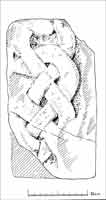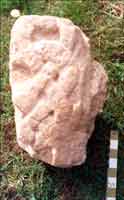![]()
The contents on this page remain on our website for informational purposes only.
Content on this page will not be reviewed or updated.
 |
 |
||||||||||||
| Saxon Period | |||||||||||||
| It is probable that a church has stood here from at least A. D. 921 when King Edward the Elder (899-924), son of Alfred the Great, fortified the town as one of a series of border strongholds against the Danes, who occupied the country to the north east of Watling Street. Towcester church is mentioned as one of four churches given by William the Conqueror in 1142 to the Abbey of Fontanelle in Normandy. Evidence of Saxon origins was discovered in the spring of 1990. While undertaking work on the tower for a new frame to receive twelve bells a stone was removed; it was totally different to the stone of the tower, which was dark brown ironstone and had been re-used and reversed from an earlier phase of construction. The reverse side of this stone is carved on one face with a simple interlace, (Interlace patterns are characteristic of Anglo-Saxon decoration). The carved pattern is in the form of a simple 2-cord, tightly woven single beaded chain plait. This Anglo-Saxon motif had been hidden for five hundred years. The Church Architect, Paul Woodfield, pronounced: “that the stone probably dates from the late tenth or early eleventh centuries A.D. and may be part of a preaching cross.” |
|||||||||||||
|
|||||||||||||
| The Anglo-Saxon stone, cut from a different ironstone to the present tower, suggests that it was either lying around in the 15th century when the new tower was built, or it may have been incorporated within an earlier Anglo-Saxon tower. The only other stone that may possibly be identified as Anglo-Saxon forms the base of the Norman shaft on the south side of the chancel arch. The corresponding base on the other side was copied in the 19th century. The two elaborately carved 12th century nook shafts were incorporated into the Victorian chancel arch in 1872. The shafts, one with zigzag decorations and the other with nested lozenges and drilled beading date from about 1170. |
|||||||||||||
|
|
|||||||||||||
|
|
|||||||||||||


